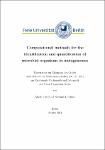Computational methods for the identification and quantification of microbial organisms in metagenomes
Lindner, Martin Michael Serenus
Metagenomics allows analyzing genomic material taken directly from the environment. In contrast to classical genomics, no purification of single organisms is performed and therefore the extracted genomic material reflects the composition of the original microbial community. The possible applications of metagenomics are manifold and the field has become increasingly popular due to the recent improvements in sequencing technologies. One of the most fundamental challenges in metagenomics is the identification and quantification of organisms in a sample, called taxonomic profiling. In this work, we present approaches to the following current problems in taxonomic profiling: First, differentiation between closely related organisms in metagenomic samples is still challenging. Second, the identification of novel organisms in metagenomic samples poses problems to current taxonomic profiling methods, especially when there is no suitable reference genome available. The contribution of this thesis comprises three major projects. First, we introduce the Genome Abundance Similarity Correction (GASiC) algorithm, a method that allows differentiating between and quantifying highly similar microbial organisms in a metagenomic sample. The method first estimates the similarities between the available reference genomes with a simulation approach. Based on the similarities, GASiC corrects the observed abundances of each reference genome using a non-negative lasso approach. In several experiments we showed that the abundance estimates are highly accurate and reduce the error compared to current approaches by 5% to 60%. The approach was also successfully applied to metaproteomics. In the second project, we developed a statistical framework to fit mixtures of discrete distribution functions to the histograms of sequencing coverage depth after mapping metagenomic reads to reference genomes. We tailored a family of distributions for this particular application and modified the expectation-maximization algorithm to also fit discrete distributions when maximum likelihood estimation of the distribution parameters is not directly possible. The most important application of our framework is the genome validity score that measures how suitable a reference genome is for a particular (metagenomic) dataset. In the third project, we developed a taxonomic profiling tool, called MicrobeGPS. In contrast to previous approaches, MicrobeGPS identifies and characterizes organisms in a metagenome even if there are no suitable reference genomes available. Distances to existing reference genomes are measured with the genome validity score and allow the user to spot organisms for which the available reference genomes are insufficient. We demonstrated on gold standard and real metagenomic data that our approach is more accurate than other existing methods, provides more meaningful results, and handles complex microbial communities. Taken together, these three projects enhance the current repertoire of computational methods for taxonomic profiling and enable the simultaneous quantification of highly related organisms and the identification and characterization of unknown organisms in complex metagenomic datasets.
Dateien zu dieser Publikation
Keine Lizenzangabe

